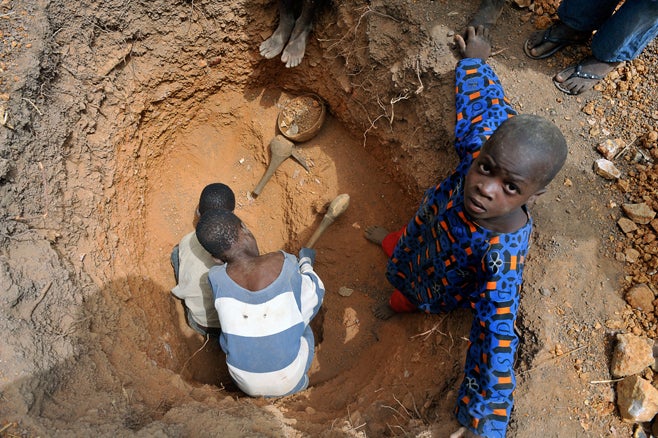
Photo: Human Rights Watch
I spent the other day watching a couple illuminating shows on the price of gold. The first was on Fort Knox and America’s precious national treasure and the second was a historical documentary on gold mining from pre-gold rush until today. It is well known that gold can come at an incredibly high human and environmental cost, but these programs further opened my eyes to the greed and destruction that this mineral has caused through history. What amazes me most is that we have learned so little: gold continues to be coveted at any cost and gold mining isn’t much safer today than it was a hundred years ago.
For thousands of years people have gone to extremes for the sake of gold, traveling the world in search of even a flake of the metal in the dirt, they risk their lives, spend all they have and most end with up with very little, if anything at all. Gold has been used to fuel armed conflicts and conquests, and has been the sole reason to level entire mountains and forests, forever changing the environmental landscape. So if gold causes so much death and destruction than why is it so highly valued? We do not need gold to survive, in reality it has little practical use for mankind, but gold continues to be one of the world’s most desired commodities. In fact, its value seems to be increasing as the global economy remains unstable. On September 10, 2001, they day before the United States terrorist attacks, gold was valued at $271 an ounce, it then hit $1,023 by March 2008, thanks to the recession and decline of the dollar. “Gold has always had this kind of magic,” says Peter L. Bernstein, author of The Power of Gold. “But it’s never been clear if we have gold—or gold has us.” Today gold fetches the highest price that is has ever garnered in history. Yet gold comes with another, higher price.
According to a Human Rights Watch (HRW) report released this past December, some 20,000 – 40,000 children work in artisanal gold mines in Mali, Africa’s third-largest producer of this precious and highly coveted metal. The 108-page report, “A Poisonous Mix: Child Labor, Mercury, and Artisanal Gold Mining in Mali,” brought to light the plight of children as young as six years-old who labor in the dangerous mines digging shafts, working underground, and pulling heavy weights of gold ore. Many of these children are placed in even deadlier conditions working with toxic mercury, used to separate the gold from the ore. HRW children’s rights researcher Juliane Kippenberg said children carried loads heavier than their own weight, climbed into unstable shafts, and touched and inhaled mercury. Mercury is especially harmful to young children; it is considered to be one of the most toxic substances on earth as it attacks the central nervous system. Symptoms of mercury poising include impairment of vision, hearing, speech, sensation and a lack of coordination.
Our demand for this shiny commodity has left many in need at the mercy of those who will only exploit them for the highest price they can get for gold. Many children work alongside their parents to supplement meager incomes, much of which is paid out in bags of dirt that hopefully contains a bit of gold. Other children find themselves alone in the mines, trafficked, exploited, and abused by relatives or strangers who take any earnings they may make with no regard for the child’s health or safety. Both boys and girls are trafficked to work in the mines and many of the girls are sexually abused.
In the report, HRW urges the Malian government to not only enforce existing child labor laws and seek compulsory education for all children, but also asks corporate entities “to put in place procedures to ensure their gold has not been mined by children.” However, there is much that must be done in the gold industry to guarantee that gold mining meets ethical and environmental standards. Currently there is no way to be sure the gold you buy untainted, as there is no set global standard or monitoring body for the metal. While many local officials and companies profit from existing gold mining practices in countries like Kenya and Mali, fights to override corruption and maltreatment are difficult.
What can you do as a gold consumer? The simple answer is to refrain from purchasing the precious metal. But other options include recycling current gold or buying antique or used pieces. Sadly, many other minerals and gems are tainted by slavery, such as diamonds. To be a conscious consumer, ask questions and look at industry standards. A growing option for untainted gems is man-made stones. I personally love my lab-created gems; they are more precious given that children were not endangered for me to wear them.